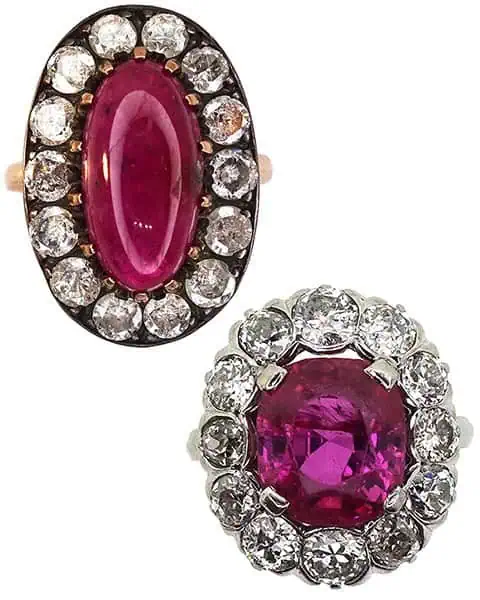Gemological ruby appraisal for jewelry and rubies

Would you like to have your ruby jewelry or rubies valued?
Rubies – like sapphires – belong to the corundum group and are the second hardest natural gemstones after diamonds. The only difference between the two colored gemstones is their color: the color of a ruby is influenced by the content and ratio of chromium and iron in its crystal structure. The color spectrum of rubies ranges from deep blood red to lighter shades of pink, purple and orange-red. The color of some rubies becomes even more intense and vibrant when exposed to UV light.
The rare star rubies have inclusions of rutile needles, which create the impression of a wandering star on the surface. Vivid, transparent and intensely colored star rubies are considered valuable gemstones.
Which rubies does the GLA rate?
In our laboratory, we assess both rubies and pieces of jewelry created with rubies or other colored gemstones. In the case of loose stones, the Gemmological Laboratory Austria only evaluates cut gemstones.
How is the value of a ruby determined?
The quality of a ruby is determined – based on the criteria for diamond grading – using the 4 Cs as follows:
- Carat (weight)
- Color (Color)
- Clarity (purity)
- Cut
In addition to the color, saturation and intensity are also decisive for the value. Rubies with an intense, vivid red are particularly sought after. The glow of a ruby is completed by a precise cut with perfect proportions.
What influences the value of rubies?
Natural rubies in vivid red, which are untreated, are considered particularly rare and valuable because the heating of rubies and other colored gemstones – to improve color and purity – has become customary.
The following factors reduce the value of a ruby or your ruby jewelry:
- Visible and numerous inclusions
- Damage and signs of wear
GLA – Your partner for rubbing reports
Artificially created rubies have been circulating on the international gemstone market for over 100 years. Ruby synthetics are usually indistinguishable from natural stones with a magnifying glass alone. For this reason, auction houses and gemstone dealers commission gemmological reports to verify the authenticity of a gemstone.
The Gemmologisches Labor Austria has specialized in appraisals for coloured gemstones and diamonds since 1979 and is in demand internationally for its objectivity and independence. Since 2010, the appraisals have been carried out by the generally sworn and court-certified expert Adeline Lageder, who is regarded as an industry expert.

This is how your rubbing appraisal is carried out:
Your rubies are graded according to scientific criteria in our state-of-the-art laboratory. The weight and dimensions, color, purity, cut (type, shape, quality) as well as any treatments, damage and other value-reducing defects of the ruby are examined. Inclusion diagnostics, spectrometry (such as FT-IR, UV-VIS-NIR, ED-XRF) and the appearance of fluorescence are used to distinguish a ruby from a synthetic.
If you are interested in the origin of your rubies, this can usually be narrowed down to a specific region using inclusion diagnostics. Historically, the best-known ruby deposits were in Myanmar (Burma), with particularly high-quality rubies being mined in the Mogok region. In recent years, Mozambique has established itself as an important supplier of rubies alongside Thailand, Sri Lanka and Madagascar.
The GLA values rubies on the basis of the respective quality criteria of our internal grading system for coloured gemstones, which is recognized by courts, banks and insurance companies. Numerous renowned auction houses and gemstone dealers in Europe rely on the quality of our diagnostic and/or appraisal reports. In order to determine the value of the desired trade level, we compare internal laboratory and international price lists as well as current developments on the gemstone market.
We will be happy to provide you with a free initial consultation.
Make an appointment for your ruby appraisal now!
